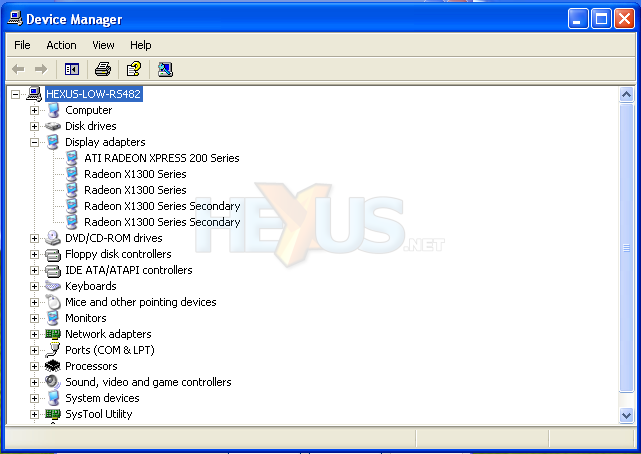System setup and notes
System setup and notes
Hardware
|
|
|---|---|
| Processor(s) | AMD Athlon 64 AM2 3500+ 2.2GHz, single-core, 512Kib L2 cache, |
| Mainboard(s) | ECS RS485M-M ATI RS485 ATI SB460 |
| Memory | 2 x 256MiB Crucial PC4200 |
| Memory Timings | 4-4-4-12 @ 488.8MHz, 1T |
| BIOS Version | 1.0e (06/05/2006) |
| Disk Drive | 160GB Seagate Barracuda 7200.9 (3Gb/s) |
| Graphics Card(s) | HIS X1300 512MiB HyperMemory with 128MiB GDDR2 - x1 PCIe (452/504) ATI Radeon X1300 PRO 256MB x16 PCIe (594/792) ATI Xpress 1100 256MiB HyperMemory (integrated X300-class - 300/500) |
| Graphics Driver | 8.243-060404a-033273E-ATI |
| Operating System | Windows XP Professional, SP2, 32-bit |
| Core Logic Driver(s) | Catalyst 6.2 |
Software
|
|---|
|
Notes
To keep it as real-world as possible, we'll be benchmarking the HIS X1300 512MiB HyperMemory with 128MiB DDR2 x1 PCIe card in our low-end testing system which comprises of an AMD Athlon 64 AM2 3500+, 512MiB of DDR2 memory, and ECS motherboard that features integrated Radeon X300-class graphics. Having a total of 512MiB of system memory ensures that the HIS card's HyperMemory technology can utilise 256MiB, and, as noted before, the x1 PCIe link will have bandwidth implications once HyperMemory is activated.We tested the HIS x1 PCIe card on the ECS board's x16 slot. The reason for doing so lies with the fact that integrated graphics engine cannot be deactivated in the BIOS unless the card is positioned in the x16 PCIe slot. Keeping the HIS card in the x1 slot, then, would have integrated graphics chewing at system bandwidth further. We've included results of x1 and x16 slot performance in the 3DMark05 test. It's worth noting that the card is physically limited to a x1 PCIe interface, irrespective of slot used.
We've also added in a regular Radeon X1300 Pro, equipped with a dedicated 256MiB framebuffer and clocked in at 594MHz core and 792MHz GDDR3 memory. Further, we've also added in the ECS' integrated graphics, which utilise a 256MiB framebuffer derived completely from HyperMemory. Both discrete cards will be tested with our standard low-end game settings but integrated graphics, with a view to mimicking real-world settings that users would employ, runs Quake 4 and Splinter Cell: Chaos Theory at lower quality settings. You can see the differences detailed here.
On a practical note, the HIS X1300 512MiB HyperMemory with 128MiB GDDR2 x1 PCIe card can be run in conjunction with other GPUs to create multi-monitor nirvana.


How about SurroundView from three sources?
Let's get to the numbers, shall we.









